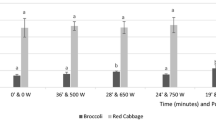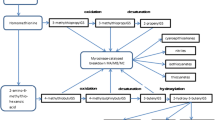Abstract.
The effect of different cooking times on the GLS content in white cabbage (Brassica oleracea L. var. capitata f. alba) was determined. Cooking of cabbage for 5–30 min caused a gradual decrease in the GLS content. The most efficient reduction of the GLS content (by about 35%) occurred during the first minutes of cooking. As the cooking time was extended by another 5 min, each time the GLS content decreased by 10–15%. Higher losses in indole GLS, as compared to those of aliphatic ones, resulted from more efficient diffusion of those compounds to cooking water. The GLS content in cooking water, irrespective of the cooking time of white cabbage, remained rather stable, whereas the content of indole GLS was between 3.5- and 4-fold higher in comparison to that of aliphatic GLS. Taking into consideration the rate of changes in the content of particular GLS in cabbage and the GLS content in cooking water, it can be stated that glucoiberin was more thermolabile than other GLS.
Similar content being viewed by others
Author information
Authors and Affiliations
Additional information
Revised version: 6 November 2000
Electronic Publication
Rights and permissions
About this article
Cite this article
Ciska, E., Kozłowska, H. The effect of cooking on the glucosinolates content in white cabbage. Eur Food Res Technol 212, 582–587 (2001). https://doi.org/10.1007/s002170100293
Received:
Issue Date:
DOI: https://doi.org/10.1007/s002170100293




